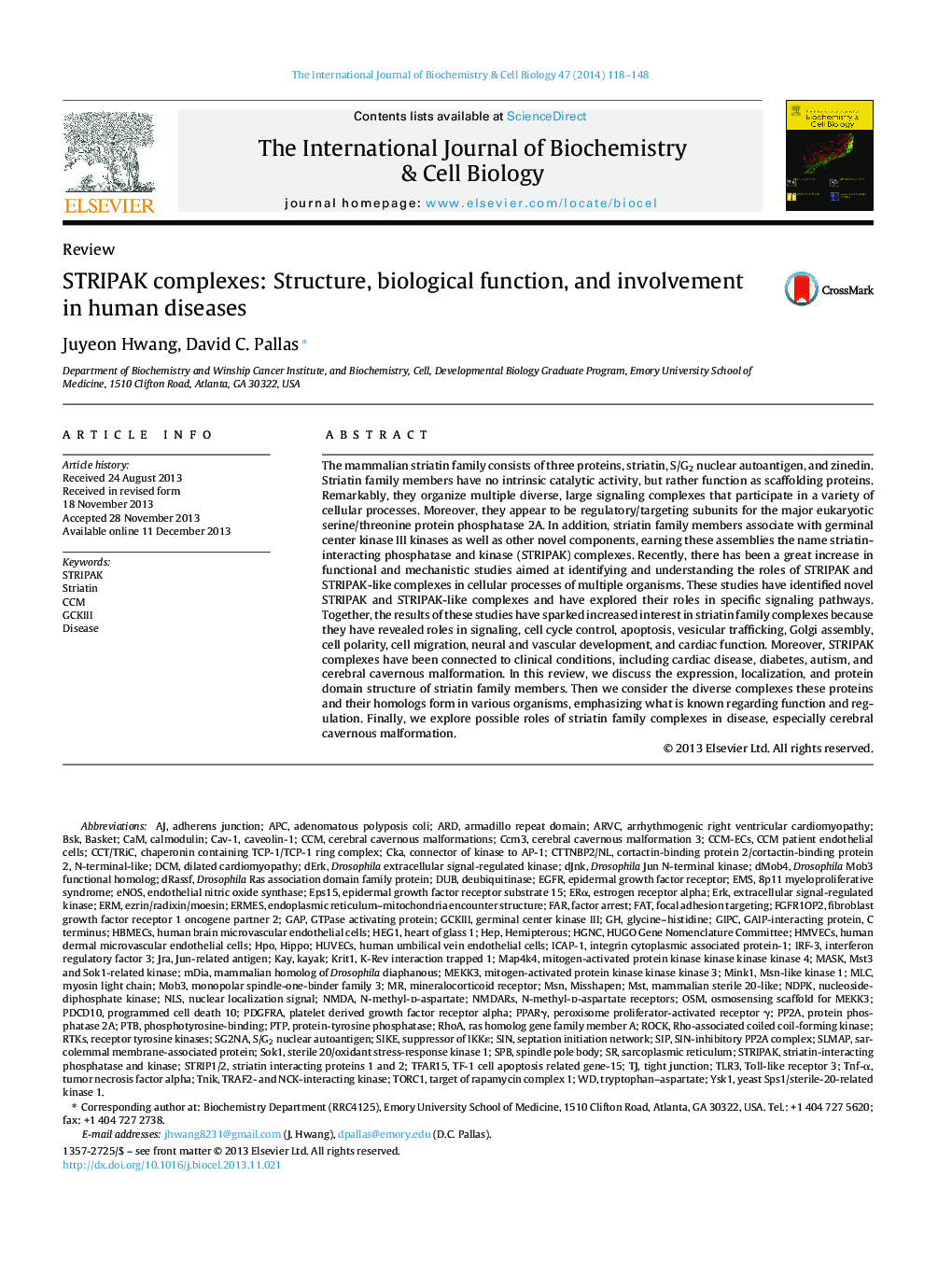| Article ID | Journal | Published Year | Pages | File Type |
|---|---|---|---|---|
| 1983582 | The International Journal of Biochemistry & Cell Biology | 2014 | 31 Pages |
Abstract
The mammalian striatin family consists of three proteins, striatin, S/G2 nuclear autoantigen, and zinedin. Striatin family members have no intrinsic catalytic activity, but rather function as scaffolding proteins. Remarkably, they organize multiple diverse, large signaling complexes that participate in a variety of cellular processes. Moreover, they appear to be regulatory/targeting subunits for the major eukaryotic serine/threonine protein phosphatase 2A. In addition, striatin family members associate with germinal center kinase III kinases as well as other novel components, earning these assemblies the name striatin-interacting phosphatase and kinase (STRIPAK) complexes. Recently, there has been a great increase in functional and mechanistic studies aimed at identifying and understanding the roles of STRIPAK and STRIPAK-like complexes in cellular processes of multiple organisms. These studies have identified novel STRIPAK and STRIPAK-like complexes and have explored their roles in specific signaling pathways. Together, the results of these studies have sparked increased interest in striatin family complexes because they have revealed roles in signaling, cell cycle control, apoptosis, vesicular trafficking, Golgi assembly, cell polarity, cell migration, neural and vascular development, and cardiac function. Moreover, STRIPAK complexes have been connected to clinical conditions, including cardiac disease, diabetes, autism, and cerebral cavernous malformation. In this review, we discuss the expression, localization, and protein domain structure of striatin family members. Then we consider the diverse complexes these proteins and their homologs form in various organisms, emphasizing what is known regarding function and regulation. Finally, we explore possible roles of striatin family complexes in disease, especially cerebral cavernous malformation.
Keywords
EGFRMSTDCMOSMHGNCHUGO Gene Nomenclature CommitteeHUVECSRhoAERKPP2APPARγPTPEMSeNOSAPCERMNMDAN-methyl-d-aspartateMSNERαNMDARsNLSARDSPBPDGFRATLR3SIPHEPPTBEPS15MLCIRF-3KRIT1ARVCNDPKERMESSTRIPAKCCM3DeubiquitinaseDUBMAP4K4septation initiation networkTORC1MEKK3mDiaMisshapenGIPCProgrammed cell death 10PDCD10HBMECsepidermal growth factor receptor substrate 15BSKarmadillo repeat domainHMVECsJRAdJnkCCmezrin/radixin/moesinGTPase Activating ProteinHpoRTKsadenomatous polyposis coliTight junctionhippoStriatinSpindle pole bodysinFARDiseasetumor necrosis factor alphaTNIKSarcoplasmic reticulummyosin light chainCAMBasketHuman brain microvascular endothelial cellsHuman umbilical vein endothelial cellshuman dermal microvascular endothelial cellsendothelial nitric oxide synthasenuclear localization signalGAPInterferon regulatory factor 3Ras homolog gene family member ATNF-αphosphotyrosine-bindingMaskCerebral cavernous malformationstarget of rapamycin complex 1focal adhesion targetinghemipterousProtein-tyrosine phosphataseprotein phosphatase 2Aplatelet derived growth factor receptor alphaAdherens junctionFatcaveolin-1Arrhythmogenic right ventricular cardiomyopathyDilated cardiomyopathyCalmodulinCav-1kayakextracellular signal-regulated kinaseEstrogen receptor alphareceptor tyrosine kinasesEpidermal growth factor receptorMineralocorticoid receptorN-Methyl-d-aspartate receptorsperoxisome proliferator-activated receptor γToll-like receptor 3Rock
Related Topics
Life Sciences
Biochemistry, Genetics and Molecular Biology
Biochemistry
Authors
Juyeon Hwang, David C. Pallas,
